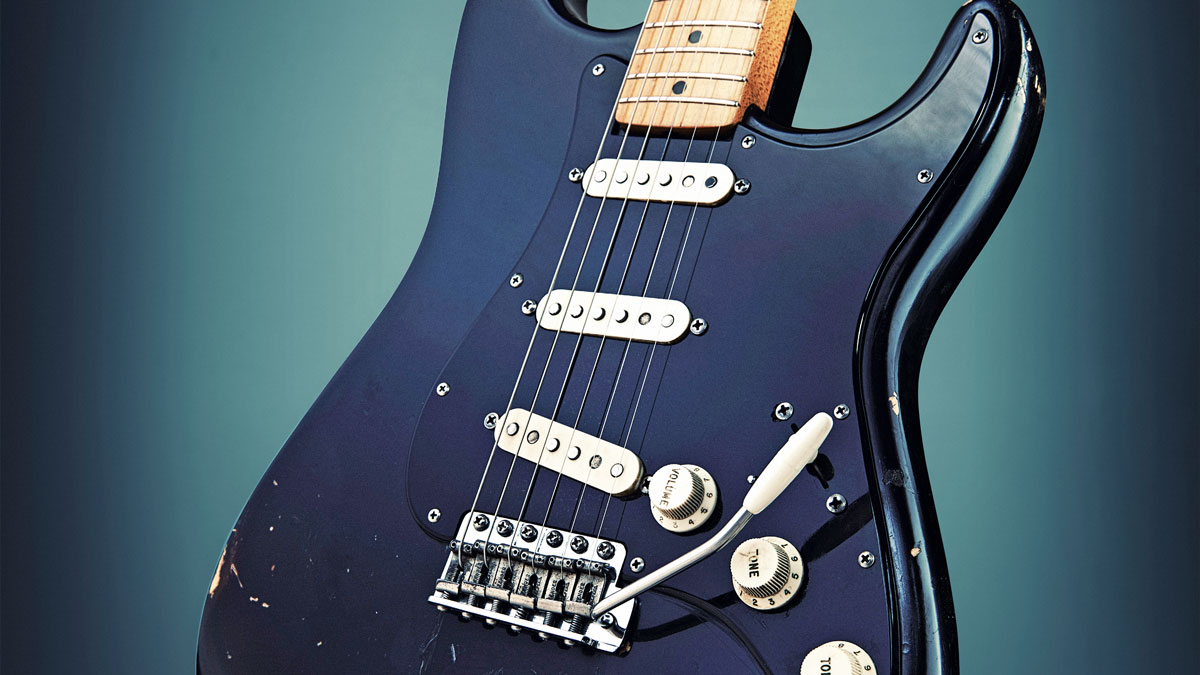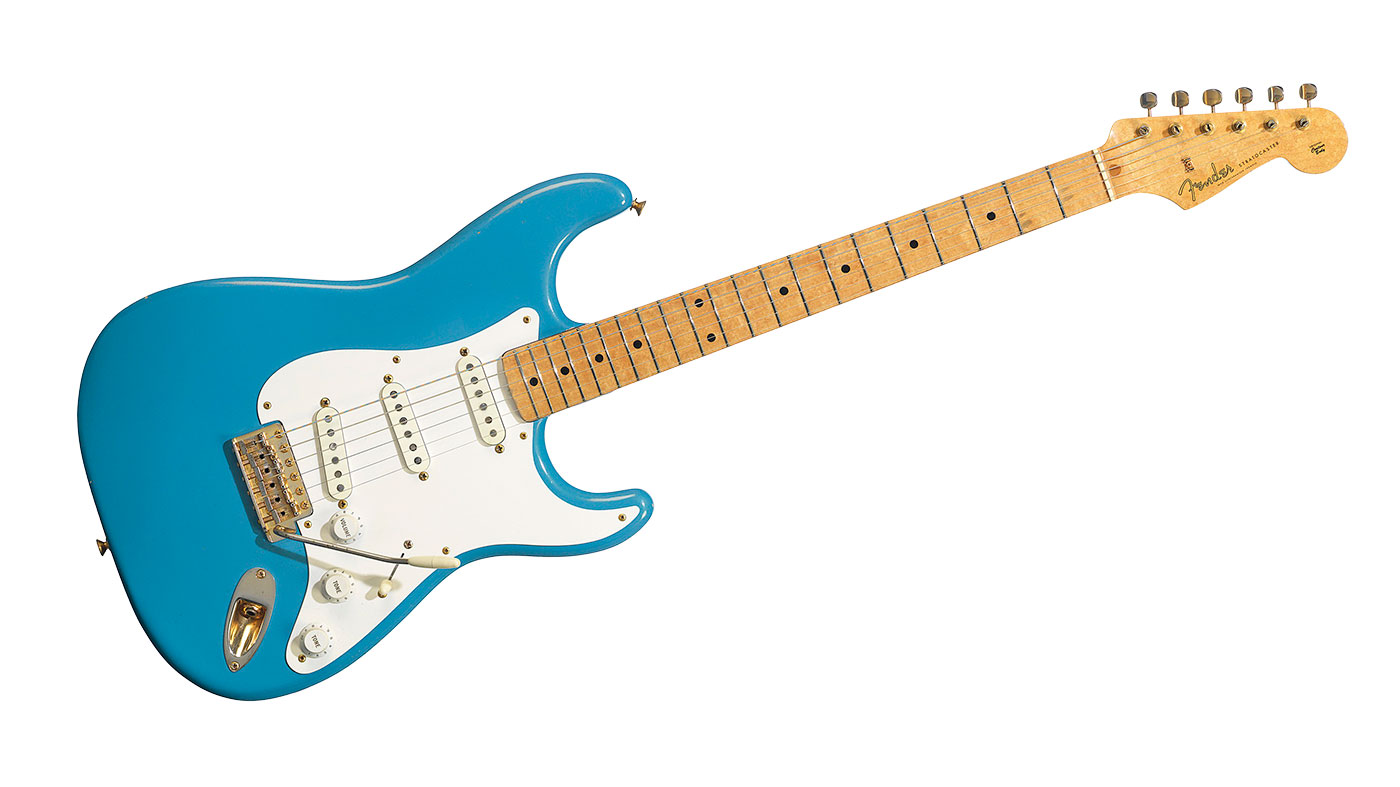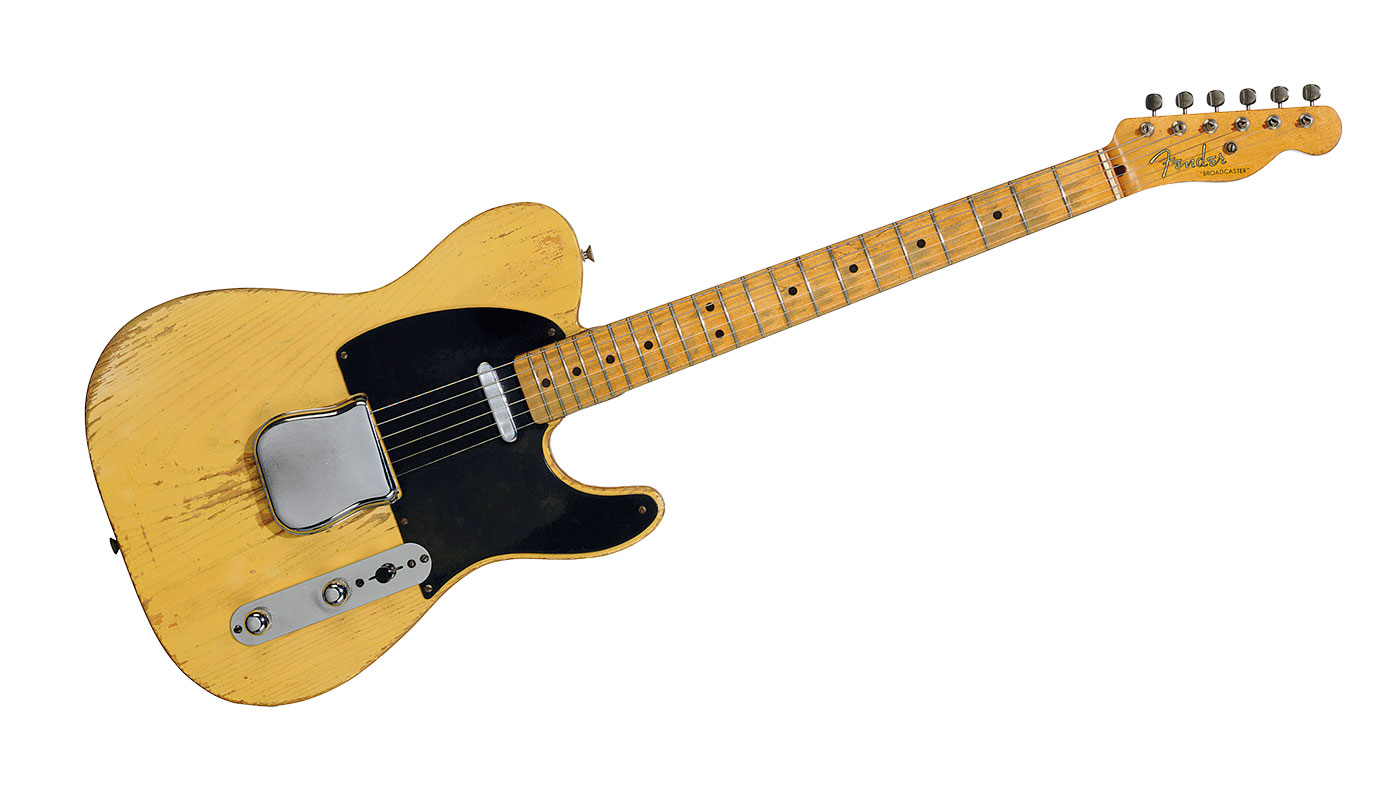
Pink Floyd guitarist David Gilmour has announced plans to sell-off 120 instruments from his astonishing guitar collection, including his fabled Black Strat, some incredible acoustics and his #0001 serial-number 1954 Strat. It is a once-in-a-lifetime event for fans and guitar obsessives alike.
Here, we take a closer look at some of the instruments entering the auction at Christie's in New York on 20 June, with input from longtime Gilmour guitar tech Phil Taylor and Kerry Keane of Christie’s New York.

The Black Strat
No prizes for which guitar is the star of the show, even in as prestigious an auction as this.
Gilmour’s Black Strat is one of the most iconic and meticulously documented guitars in history, thanks to the careful work of Gilmour’s guitar tech of many years, Phil Taylor, who wrote a book on it entitled The Black Strat: A History Of David Gilmour’s Black Fender Stratocaster, which is the standard reference on its varied and illustrious life.
As a close-up examination of the original black Strat attests, it is a much-modded guitar. It was originally a Fender 1968 to ’69 alder-body Strat with black painted over the original Sunburst. It had a Fender late-60s maple neck (large headstock) and 21 frets, but a rosewood-necked version features on The Dark Side Of The Moon and Wish You Were Here. To muddy the waters still further, it later had a Charvel neck fitted! When it came back from a spell at the Hard Rock Cafe, it was damaged and with knobs missing, so the mods have continued since then.
The now-iconic black scratchplate was added in 1974 and was custom-made, because Fender didn’t then make them
Examining the guitar, you can clearly see evidence of old routing work, which has since been filled in for the once-fitted Kahler vibrato. After the tonal properties of a Kahler vibrato fitted to the Black Strat were found wanting, the original three-spring vibrato was fitted to the guitar.
In the 70s, Gilmour also fitted an edge-mounted XLR socket to send the signal to a fuzzbox then back to the guitar - also since removed and filled in. The now-iconic black scratchplate was added in 1974 and was custom-made, because Fender didn’t then make them. The five-way pickup selector (replacing the original three-way) arrived in 1985. Meanwhile, a mini-toggle just below the pots allows independent switching-in of the neck pickup “for a more Jazzmaster-like tone”.
The neck and middle pickups are dated 1971, while the whole pickguard assembly comes from a ’71 ‘bullet truss rod’ Fender Strat in 1973. Further back, the bridge pickup is a Seymour Duncan custom-wound SSL-1C, installed in 1979, which replaced a DiMarzio FS-1. The reverse of the guitar exhibits extensive belt-buckling picked up during years of hard use. Currently, the Black Strat is fitted with a Fender 1983 ’57 reissue C-profile maple neck (from the cream/white 1983 57V Strat that’s also in the sale, see p67) with 7.25-inch radius fingerboard and 21 vintage-style frets. Tuning is handled by Fender/Gotoh vintage-style machineheads.
Also synonymous with this guitar is the shortened vibrato arm, which measures 4.25 inches. “They’re nothing special,” tech Phil Taylor told Guitarist.
“Fender make these short arms now, but I originally just hacked the ends off. The arms are screwed in tight so it never ‘flops’; that’s one thing. And David likes to have the end of the tip in the crease of his palm. He doesn’t seem to plan whether he plays finger vibrato or arm vibrato, or a combination of the two, at any one time. But with a longer arm, he may have to play closer to the neck. That would be more of a separate action to David. This is more ‘integrated’ in the way he plays. He doesn’t often play electric guitars without a trem.”
When you strum this guitar not plugged in, it has a wonderful resonance. And that attribute weaves its way through all of David’s guitars
Kerry Keane of Christie’s New York adds that while mods of this extensive nature would normally decimate the value of a vintage guitar, the Pink Floyd provenance makes them part of an incredibly compelling story of the music made with this guitar - and are typical of pro players who are always hunting for an extra advantage in tone and usability.
“There is just a brilliant photograph of David with the Black Strat - I think it’s about 1971 or ’72, during the filming of Pink Floyd’s concert in Pompeii, in the Colosseum,” Kerry recalls. “And he is legs folded, shirt off in the hot Naples sun, working on his guitar. Tweaking it. He looks like a gladiator working on his axe [laughs] on the floor of the Colosseum in Pompeii. It’s brilliant and this is what guitarists always do. They’re always trying to tweak it and make it a little better for them - both the feel of the instrument and tonal quality. What they want to hear and what they want to feel. I think it’s very similar to a race car driver always tinkering with the carburettor - back when there were carburettors [laughs].
“When you strum this guitar not plugged in, it has a wonderful resonance. And that attribute weaves its way through all of David’s guitars.”

#0001 1954 Fender Stratocaster
“What’s most interesting about this guitar is its manufacture date,” says Kerry Keane of Christie’s New York. “1954 is the first year of production for the Fender Stratocaster, but this guitar is white, not Sunburst as ’54s normally are, and it has a gold anodised pickguard and gold hardware.
“We know that this is not the very first Fender Stratocaster. But what we do know is that Leo Fender, in 1954 and 1955 and afterwards, when a musician helped him in the design or the promotion of his instruments, he would often have a fancy custommade guitar built for them and put that Number One serial plate on the back. And this is what the story is with this guitar.
Gilmour acquired ‘number one’ from Phil Taylor, who had, in turn, bought it from Seymour Duncan
“It was given to a gentleman by the name of Rex Gallion, who was a guitarist in Southern California, who was very closely associated with Leo Fender and was integral in helping Leo come up with the body shape and contour. And to pay homage to Rex, Leo gave him this guitar and a matching bass to his brother, Vaughan, who was a bass player. And then the guitar went off into the great wide world.
“It’s gone through many hands, but it’s been with David since 1978 or 1979 - somewhere around there. Not a lot of recordings or performances used this guitar. He played it in two benefit concerts in 2004. He used this on Another Brick In The Wall (Part II) for the rhythm part.”
In an article from Guitarist in 1995, it was revealed that Gilmour acquired ‘number one’ from Phil Taylor, who had, in turn, bought it from Seymour Duncan in the mid-70s. When the time came for Phil to buy a house, he approached The Bank Of Floyd for a loan for the deposit. The guitar became part of the deal and thus part of David’s formidable collection.

1957 Fender Stratocaster in Lake Placid Blue
“We’re always under the impression that in those very first years, Strats really were all Sunburst,” comments Kerry Keane of Christie’s.
“But we know that there is a photograph showing a young player picking up a red Stratocaster from Leo in Fullerton 1954. So, in fact, he was doing custom colours even then. Nonetheless, this is very early for a Lake Placid Blue Strat, without a doubt - and again, like the #0001 Stratocaster, it has gold hardware.
This was certainly a custom-made instrument made for Homer Haynes
“This was certainly a custom-made instrument made for Homer Haynes. Homer Haynes was part of a country duo called Homer and Jethro and very big on the country music circuit here in the United States. And, again, he and his mate Jethro were great promoters of Fender instruments - though, interestingly, they tended in performance not to play Fenders [laughs]; they were playing Gibsons more than anything else. But they did use Fender amplifiers, which were unrivalled at the time. Leo Fender had a very close marketing relationship with Homer Haynes. And he was a great musician, both as a performer and also as a studio player.
“This Stratocaster was not a guitar for touring; it was simply a guitar for David’s collection. What’s exciting about David’s collection is that there are the instruments that he used and played hard, and there are the instruments that he was drawn to because he realised they were very pure examples of the instruments that he used as tools.”

1984 ’57 Reissue Fender Stratocaster
This Candy Apple Red ’57-spec Strat from the early 80s is arguably the second-most recognisable Gilmour Strat after the Black Strat, which it replaced.
This example was, of course, heavily modded from stock to meet Gilmour’s stage needs. Gilmour eventually replaced the single coils on his main Red with active EMG pickups - 1979-made forerunners of what became the signature DG20s (DG still employs the originals).
The EMGs feature an EXP control boosting treble and bass, and an SPC control, boosting the midrange for a humbucker-esque tone. Gilmour also added his ‘custom’ 4.25-inch vibrato arm. The red Strat featured extensively on A Momentary Lapse Of Reason and The Division Bell albums and tours, The Endless River, plus some of Gilmour’s On An Island solo album.
Gilmour also made very wide use of a ’62-spec Candy Apple Red Strat from the same series of early 80s reissues, which featured a rosewood ’board and white 60s-style scratchguard.

1983 ‘57 Reissue Fender Stratocaster
“The cream colour Strat, actually Olympic White, that’s from 1983,” says Kerry Keane of Christie’s New York of the white ’83 Strat that is the stablemate of the better-known Candy Apple Red ’84 Strat.
The original pickups were changed out for the EMGs and there’s the SPC/EXP active electronics on there
“The neck that’s in it now is an ’89, so it’s neck-stamped May 1989. Incidentally, this neck was also on the Black Strat for a while, between 2003 and 2005. The tremolo cover has been removed, but it’s been retained. It’s got active electronics, of course, and the battery rout has been shielded in copper foil, which you’ll see in a lot of these guitars - keeps those noiseless EMGs even quieter. The original pickups were changed out for the EMGs and there’s the SPC/EXP active electronics on there.
“I believe both this and the Candy Apple Red ’84 Stratocaster were acquired direct from Fender, where David Gilmour had the opportunity to sit down in a room with multiple Stratocasters and play them, pick them up, put them down, try another one. And he would vet his guitar purchases from Fender in that manner. Very tonal, very tactile. Both these guitars are spectacular rock ’n’ roll machines - they really are wonderful. And when he retired the Black Strat, these are the two guitars that you see used most for the next 20 years.”
“We went up to the CBS/Fender warehouse in London and we tried them and bought a few,” recalls tech Phil Taylor. “Very nice guitars. David just started using them instead of his Black Strat. For a long time, he was happy with that sound. Then again, David can get a good sound out of anything.”

1950 Fender Broadcaster
“David’s first Fender was a Telecaster that got stolen, so I think he always had this love of Teles, though he found Strats more conducive to his playing.
“This was a guitar that he purchased for collecting. And it is in exquisite condition: original case, unadulterated. It’s just a classic Blackguard Broadcaster. Wonderful thing. Purchased it in 1979 from California Guitars, along with numerous other vintage instruments that he found on trips to LA.
“And, again 1979: this is an early time period to be excited about early Fender Broadcasters, without a doubt. But he knew it was the first year of production and he knew it was in great condition - and acquired it, strictly for collecting. He said he’d love to sit with this and play it alone, play it in the studio. He doesn’t bring it on the road. Again, it illustrates his connoisseurship of great electric guitars.”

1971 Martin D-12-28
“So, the 1971 12-string was purchased in 1973 and it is the primary 12-string used in the studio since then and it was, of course, used to record Wish You Were Here. David never took this on the road, never performed with it on tour. At this point of time, he was turning to Ovations for touring guitars because they’re tough and they can take a lot of abuse. He acquired this from Alan ‘Dreamy’ Lee.
It hearkens back to his youth as a young guitar player who was first listening to folk music
“What I find interesting about David’s collection and when we start looking at the acoustics vis-à-vis the electrics, the fact that he had a 12-string guitar and he played it and he performed with 12-strings… it hearkens back to his youth as a young guitar player who was first listening to folk music, who learns to play the guitar from his first method book: Pete Seeger’s [A Folksinger’s Guide To The 12-String Guitar As Played By Leadbelly]. That tonal quality winds its way throughout his career and when it was time for him to get a good 12-string, he chose a Martin.
“He was careful with this guitar. It doesn’t have a lot of belly lift, as some 12-strings do; it was pretty healthy and I write in my condition report, first and foremost, that the pickguard’s not original. That’s not uncommon in those 70s Martins; you’ll often see that the pickguards would peel up and they often get changed. I also noted that it has normal playing wear - various little scratches and dents to the finish but very well cared for, frankly.
“The neck was surprisingly straight and true. That’s not always the case, because when I worked as a guitar repair tech, Martin 12-strings were known to have necks that’d warp and the tops would belly. In fact, the 12-strings of that era that always seemed to hold up better were the Guilds, and those sound good, too. They had adjustable truss rods and at this point in time the Martins did not.”

1958 Gretsch 6134 White Penguin
“What to say about White Penguins?” says Kerry Keane of this rocking-horse-teeth rare Gretsch. “Well, I always say: find me another one. They’re extremely rare. No-one knows truly how many were made. Extrapolating from [official] production numbers, there were probably 50 and not a penny more.
The White Penguin is a matching counterpart to the Falcon that is more or less a solidbody guitar
“And it was the solidbody equivalent to another iconic Gretsch instrument of the same period, the White Falcon. And David happens to have a ’57 White Falcon that’s also included in the sale. So he’s selling the Falcon and he’s selling the White Penguin. The White Penguin is a matching counterpart to the Falcon that is more or less a solidbody guitar. Considering all the routing cavities on Gretsch solidbodies, it’s almost semi-solid, in fact.
“It’s built on the outline of the Jet series and this one is in amazing condition. Original case and in great, great condition and David purchased it specifically for collecting. He had the Falcon first and he said to Phil Taylor, ‘Listen, let’s try to find the solidbody mate to this. Let’s start looking around.’ So they started putting out feelers and found a dealer in the United States who had one, shipped it to him and he purchased it.
“By 1980, they were starting to get recognised as rare - it’s a guitar that never appeared in any Gretsch catalogue. And within the pantheon of rare electric guitars, I think it’s up there with the Flying V.”
Guitarist is the longest established UK guitar magazine, offering gear reviews, artist interviews, techniques lessons and loads more, in print, on tablet and on smartphones
Digital: http://bit.ly/GuitaristiOS
If you love guitars, you'll love Guitarist. Find us in print, on Newsstand for iPad, iPhone and other digital readers


